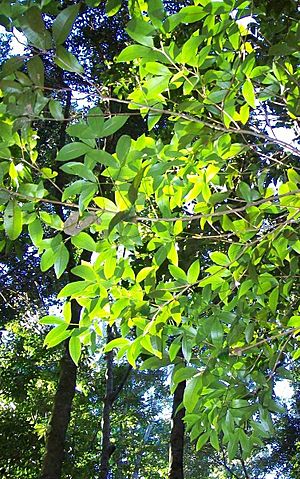Rose marara facts for kids
Quick facts for kids Rose marara |
|
|---|---|
 |
|
| Scientific classification | |
| Genus: |
Pseudoweinmannia
|
| Species: |
lachnocarpa
|
| Synonyms | |
The Rose Marara (scientific name: Pseudoweinmannia lachnocarpa) is a beautiful tree found in the rainforests of eastern Australia. People also call it mararie, scrub rosewood, or red carabeen.
Its scientific name, lachnocarpa, comes from a Greek word meaning "woolly fruit." This is because its fruit is covered in soft, golden hairs! The first part of its name, Pseudoweinmannia, means it looks similar to another tree genus called Weinmannia. This other tree was named after a German pharmacist from the 1700s, J.W. Weinmann.
Contents
What is Rose Marara?
The Rose Marara tree was first described in 1874 by a scientist named Ferdinand von Mueller. He gave it the name Weinmannia lachnocarpa. Later, in 1930, another scientist, Adolf Engler, gave it the name it has today. This tree belongs to a plant family called Cunoniaceae.
Where Does Rose Marara Grow?
You can find the Rose Marara tree in special rainforest areas. It loves places with good soil, like where rivers have left rich dirt or where volcanoes once were. It also needs a lot of rain to grow well.
These trees grow from the Richmond River in New South Wales all the way up to Cooktown in tropical Queensland.
How to Spot a Rose Marara Tree
The Rose Marara can be a small tree or a very large one. It can grow up to 40 metres tall, which is like a 13-story building! The bottom of the tree often has a very wide base, sometimes as wide as 2.5 metres. This wide base helps the tree stay strong and upright.
The bark is thin and usually grey or fawn in colour. If you touch it, it feels a bit rough, with small bumps and flakes. The smaller branches are smooth and can be greyish-white or brown. The tips of the branches are green, and they have small white oval spots called lenticels, which help the tree breathe.
Leaves of the Rose Marara
The leaves of the Rose Marara grow in groups of three, opposite each other on the stem. Each leaflet is about 3 to 15 centimetres long and 1 to 5 centimetres wide. They are oval-shaped and have small teeth along their edges. The leaves are a shiny green colour and don't have much of a leaf stalk. You can easily see the veins on both sides of the leaves because they are raised.
Flowers and Fruit: The Life Cycle
White flowers appear on the Rose Marara tree in August. They grow in clusters called racemes, which are about 5 centimetres long. Just like its relative, the Coachwood tree, the flowers of the Rose Marara don't have petals.
The fruit of the Rose Marara ripens between February and April. It's a small, oval-shaped capsule, about 6 to 9 millimetres wide. This fruit is covered in those golden, woolly hairs that give the tree its name! Inside, the seeds are tiny, only about 1 millimetre wide. It can be tricky to grow new trees from these seeds.

